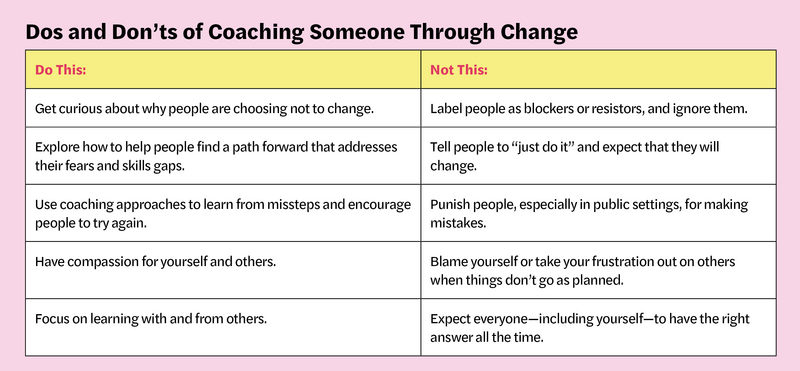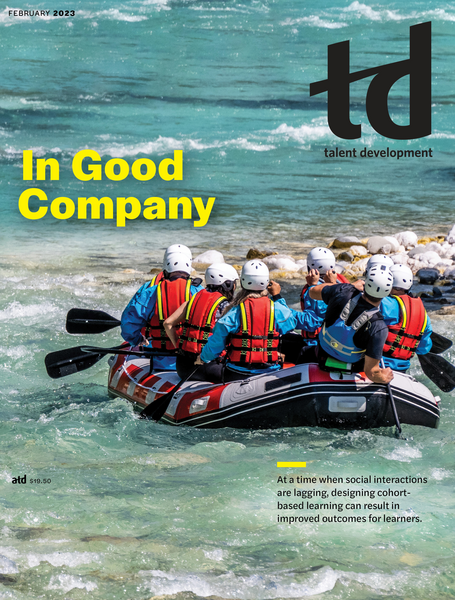TD Magazine Article
Inspire Change With In-the-Moment Coaching
In this world of fluid change, in-the-moment coaching is how to keep ourselves afloat.
Wed Feb 01 2023

Sometimes it feels like we are drowning in relentless waves of change. The fluidity of the world means that change has become a way of life, so we need to find a way to stay afloat. That begins by noticing that change has changed, so we must likewise alter our response to it.
Note that changing people is different from changing things. Legacy approaches to change focus on altering processes and procedures by making detailed plans and implementing them. That approach works well on things. But when it comes to changing people, that plan often doesn't work well because individuals need to choose to change before they will fully engage in the learning process that behavior change requires. That's why taking a coaching approach to supporting any kind of change is imperative.
At Cylient, we define coaching as the translation of insight into meaningful action to realize potential. It's the igniting of insight that drives the learning and engagement that coaching creates. Recall the last time you had an "aha" experience of learning something new. That good feeling that accompanies the learning is what motivates people to try new things. Coaching that ignites those kinds of insights is the type of coaching that motivates people to change. Anyone, at any time, can weave that kind of coaching into any conversation—that's what in-the-moment coaching is.
Spark change
Coaching moments are happening all the time, all around us, particularly when change initiatives evolve and collide, creating new waves of challenge. Examples of coaching moments include times when people are not sure how to quickly modify plans, resolve a disagreement with a stakeholder, or inspire others to adjust to new priorities. Those moments happen in the flow of work, in everyday conversations with your co-workers and external partners. Many of them happen in shared settings such as team meetings and group conversations.
Using coaching approaches when things get a bit choppy transforms such moments into opportunities for people to learn with and from others. Addressing real challenges in real time is needed to keep change moving forward in a positive direction.
Let's look at some examples to see how in-the-moment coaching works. In the following scenarios, the term coach means the person who is choosing to take a coaching-based approach to the situation. The individual could be a leader, a peer, or anyone, really. Everyone can use in-the-moment coaching at any time, with anyone.
Someone is complaining about something
People complain about change all the time. It's easy to become annoyed when that happens. Telling the person to get over it doesn't help, though. In fact, that traditional leadership approach often makes the situation worse because it creates resistance to change. Taking a coaching approach begins with a coaching worldview. That means that the coach has compassion and understands that individuals complain about what they care about but don't know how to influence or resolve by themselves. That's a great opportunity for coaching.
It's important for the coach not to label the person as a blocker; rather, get curious about what the person is afraid of or concerned about. Asking a simple question such as "What is concerning you the most about this?" and then listening carefully for what the person says—and doesn't say—will give the coach valuable clues as to what fears may underlie the complaint. Then the coach can use coaching approaches, such as asking questions, to help the person feel more empowered, even if they can't change or resolve the situation completely.
For example, if the person is frustrated that they are not getting the clear direction they want to move forward with an assignment, a coach may ask "What can you do with the information that you have right now?" or "What do you need to take the next step on this project? Who can help you with that?"
The key is to help the person identify what they can influence or control. Do they need support to learn a new skill? Would it help to think through what they would do if what they fear happens? Perhaps exploring who can help them will help them feel less alone. Taking a coaching approach to complaints turns them into opportunities to help people move through their fears and gain more self-confidence.
Someone is avoiding something
Another common response to change is to avoid doing something that must be done—for example, perhaps Astrid is avoiding having a conversation with her peer to resolve a difference between them. To take a coaching approach to that scenario, the coach can begin by exploring how Astrid views the situation using open-ended questions that invite her to share her perspective, such as "How do you see this situation with you and Kendra?" Listen for disconnects. Maybe Astrid doesn't think it's her responsibility to deal with that. Or perhaps she doesn't feel confident that she has the skills to handle the situation if Kendra becomes upset.
After exploring Astrid's perspective, the coach can use coaching approaches to help Astrid see how addressing the situation could be beneficial to her. For instance, the coach could share a story that helps Astrid see that demonstrating that she can successfully manage conflicts like this will enhance her credibility to be viewed as the emerging leader she aspires to be.
Once Astrid understands how she can benefit from the change, the coach should explore whether she has any fears about moving forward. To do so, the coach could offer an observation such as "It sounds to me like you're concerned about how Kendra may react if you raise this issue with her" and then see how Astrid responds. Her reaction will help the coach home in on what is keeping Astrid from moving forward. If Astrid agrees, the next step may be to help her think through how she could address what is concerning her.
Coaching people through day-to-day challenges is a fantastic way to help individuals learn how to think for themselves. Once you've coached someone through a situation a time or two, they will be able to handle situations like that on their own. And they may even coach others on how to handle similar challenges, because in-the-moment coaching is contagious—in a good way.
A team is stuck
When a team grinds to a halt on a project, it is often because team members are arguing over who is and isn't right. That dynamic is fueled by the old belief that the team can't move forward until it has figured out what the right answer is. For many reasons, it's getting harder to find definitive answers as problems become more complex, change happens more often, and teams face challenges they've never seen—or even imagined—before.
The goal in taking a coaching approach when a team is stuck is not to referee who is right or wrong; rather, it's to get the team working together to figure out a productive path forward. The coach can start by drawing people's attention to what is stuck without assigning blame—for example, making an observation such as "It sounds to me like we're having some difficulty identifying what we are trying to accomplish right now." Next, the coach should pause to see what response they get. That approach reframes the conversation to address the shared challenge rather than assigning blame.
Afterward, the coach could ask coaching questions that focus on illuminating what is stuck—for instance: "What are we not discussing that we need to talk about?" The coach can invite team members to share their thoughts and ideas while encouraging people to listen to each other. The key is to illuminate major themes with a focus on supporting the team to find common ground and productive next steps.
The coach must approach impasses as an opportunity to get curious about what is stuck and work together with the team to unearth limiting assumptions, beliefs, and concerns that are keeping it from moving forward. Working in such a way builds trust within the team that can reduce future team disconnects.

A group of people seems hesitant to embrace a change
Here's a true story: A company planned to implement a software program enterprise-wide. Leadership had tasked Amelia and others on her team with demonstrating the new software to leaders in select departments. After one of her presentations, she sensed that some participants were not on board with the idea of changing software programs. If Amelia had taken a traditional approach to change, she may have just ignored their concerns or told them that the change was going to happen regardless of whether they supported it.
Instead, she took a coaching approach to the moment by asking questions about their concerns. Amelia learned that many of the leaders had used the same software for years and were very skilled in it. She considered how she could support them to move through the change with more confidence. Then she used a coaching approach of telling a story about her own experience of learning the software. Amelia explained that it took some time for her to get used to the software at first, but with some practice and training, she was able to learn it quickly. And if she was able to learn it quickly, she was sure that the more experienced employees would be able to use it effectively as well. A wave of relief flowed through the audience as Amelia shared her experience.
Those who take a coaching approach to change use their coaching skills to tune into how others are feeling and then change strategies when they sense that people need support to align with a change initiative.
Integrating in-the-moment coaching
So, how do individuals begin to weave these ideas into the flow of their everyday work?
**Get curious.**Curiosity is a foundational element of coaching. Coaches should ask themselves: How does this person see the situation? When people switch to curious mode, the judgments about themselves and others drain away. Coaches should invite the other person to share their perspective with queries such as:
Tell me more about what's going on.
What's concerning you the most about this?
What has kept you from taking action so far?
Stay curious. While an individual is sharing their perspective, it's imperative for coaches to stay curious and not revert to telling the individual what they think the person should do. Coaches can keep curious by asking themselves:
What is this person not aware of that is affecting the situation? For example, are there other options available to them? What hidden agendas may be at play?
What may this person be afraid of or concerned about?
What skills or capabilities may this person lack that keeps them from addressing the situation successfully?
Ignite insight. Remember that insight is the engine that drives coaching. The burst of energy that people experience when they learn something new inspires them to take action. It may take several coaching approaches to ignite insight. Coaches can try:
Using a metaphor or analogy
Asking a reflective question (for example, "How does the other person possibly view this situation?")
Telling a story that inspires new ideas
Sharing an observation (for example, "I get the sense that you and your teammate may have different ideas of what a successful outcome will be. What do you think about that?")
Take forward momentum. In some situations, it may be helpful for coaches to support the individual to feel confident to take action on what they learned. That is not always the case in in-the-moment coaching. Some questions coaches can ask to get a feeling for the person's confidence could be:
What would be a good next step for you?
What support do you need to move forward?
Teaching people in-the-moment coaching skills is like giving them swimming lessons—it can make change less scary and maybe even fun. When that happens at scale, learning in the flow of work becomes a way of life, enabling organizations to ride waves of change to their advantage, rather than being overwhelmed by them.

